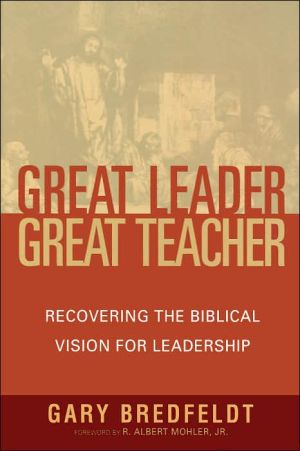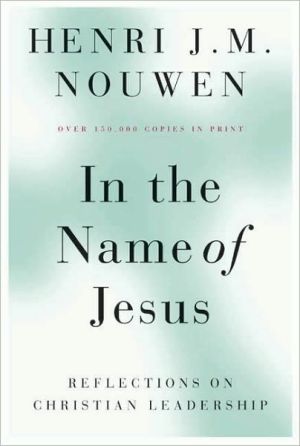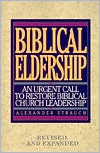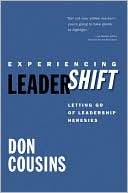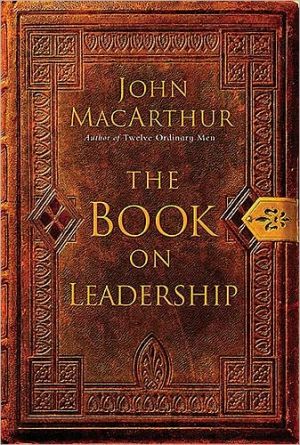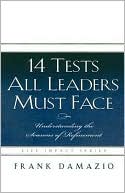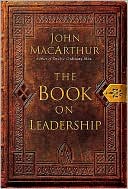Great Leader, Great Teacher: Recovering the Biblical Vision for Leadership
So many contemporary leadership philosophies, even within the church, are based on worldly examples of success. These methods force church leaders to become businesslike CEOs, dramatic visionaries, or savvy stategists abandoning their true calling as teachers. This book calls readers to be what the Bible empowers them to be, teachers who follow Christ's example of leading by serving, suffering, and sacrificing for the sake of others.
Search in google:
So many contemporary leadership philosophies even within the church are based on worldly examples of success. These methods force church leaders to become businesslike CEOs, dramatic visionaries, or savvy strategists abandoning their true calling as teachers. This book calls readers to be what the Bible empowers them to be, teachers who follow Christ s example of leading by serving, suffering, and sacrificing for the sake of others.
GREAT LEADER GREAT TEACHER\ RECOVERING THE BIBLICAL VISION FOR LEADERSHIP \ \ By GARY BREDFELDT \ MOODY PUBLISHERS\ Copyright © 2006 Gary Bredfeldt\ All right reserved.\ ISBN: 0-8024-1147-9 \ \ \ Chapter One\ ACHIEVING MAXIMUM LEADERSHIP: TEACHING THE WORD And the things you have heard me say in the presence of many witnesses entrust to reliable men who will also be qualified to teach others. -2 Timothy 2:2 \ THE greatest of leaders among us are not powerful senior executives, commanding military strategists, celebrated athletic coaches, or respected political figures. No, the greatest leaders among us are the great teachers among us. In a hundred ways and in a hundred different arenas, great teachers, every day, influence through their passion, their character, and their words. Teachers shape, challenge, and change people, and in doing so, they lead. Great teachers are leaders, and conversely, great leaders must be teachers.\ Defining leadership is an elusive thing. Is leadership a position? Is it a person? Is it a process? Maybe it is power and influence. And once we define it, what role should one play in exercising it? Should one take the role of a commander, a coach, colleague, or simply co-laboring community member?\ The confusion over how to define leadershipgrows out of the complexity of leadership itself. The nature of leadership differs from situation to situation. What is required of a leader on the battlefield is quite different from what is required on the ball field or mission field. Leadership is not a one-size-fits-all formula. The nature of leadership shifts with the context, the followers, the task, and even the leader himself or herself. What is clear is that leadership is dynamic and requires openness and flexibility on the part of those who must exercise leadership in their work, ministry, or family contexts.\ In recent days, new winds have been blowing in the leadership realm. There are calls to abandon "hierarchal" and "heroic" models of leadership in favor of "authentic," "transformational," and "post-heroic" models of leadership. Even in the church, new voices are being heard that call for a departure from a "leadership of ideology" to a "values-driven" leadership and from a "leadership of controlling hierarchy" to a leadership of "empowered networks of Christ followers." Out is the management emphasis of strategic planning and in is a new emphasis on learning, development, and mutuality where authority is replaced with authenticity. Today, leadership has become distributed and decentralized and less vested in a single individual at the top of the organizational pyramid. The question is this: Is that a positive thing or a negative thing for the church? Are we heading the right direction, or could we simply be watching a pendulum reaction to the marketing approaches to leadership popular in the 1980s and '90s?\ Authors like Peter Senge from a business perspective and Eddie Gibbs from a church perspective are challenging the very foundations of our thinking about leadership. Immersed in the currents of contemporary culture, these authors call leaders to a postmodern approach to the task of leadership where leaders no longer have the answers, but instead create a climate where followers are empowered, collaborative, and freed to pursue shared goals in their own way.\ Those, like me, who embrace a firm, conservative commitment to the ultimate authority of Scripture as the Word of God are concerned. We wonder, are these new winds threatening to blow the church off course? And if the church follows the powerful currents of postmodern culture when it comes to leadership, does it run the risk of losing its rudder altogether for the sake of remaining contemporary and responsive to cultural shifts? If the relativism and experience-driven standards of culture are embraced, it seems likely that the church will simply be pushed along and become indistinguishable from the world to which it is to be a witness.\ This book is a call to leadership by the Book, that is, the Bible. It is an exploration of the most fundamental aspect of biblical leadership: the teaching of the Word of God as the life-changing power of God. It reflects an unabashed commitment to Scripture as propositional truth, often embedded in the communication vehicle of story. At the most basic core of biblical leadership is one indispensable, unchanging function of the Christian leader-the task of teaching God's Word with clarity, in its original context, and in a way that is relevant to those whose hearts are open to hear. This is leadership in its simplest, most distilled form. The biblical leader is first and foremost a Bible teacher, and the people of God are a distinctive teaching-learning community where the principles of business leadership may not always apply.\ Leading God's Teaching-Learning Community\ The National Aeronautics and Space Administration (NASA) is an example of the best and worst in leadership. The amazing rescue of Apollo 13 is a testament of human ingenuity and creativity, a wonderful expression of teamwork at its best. Apollo 13 left its launching pad on April 11, 1970 bound for the moon. But just a day into the mission an explosion occurred that damaged the spacecraft. The damage was severe, making the command module useless and causing life-supporting oxygen to vent from the side of the craft. With no options but to abort the mission to the moon, plans turned to a rescue. The challenge was to figure out a way to use the lunar lander as a lifeboat in order to get the spacecraft and its crew safely to Earth. The task required considerable improvisation by the crew and the support workers on Earth. In a matchless feat of teamwork and leadership, the rescue succeeded and all returned safely. The astronauts and the ground crew engaged together in a tremendously complex learning activity. Apollo 13 was an example of a learning organization at its best.\ Not all of the stories that surround NASA have had such a positive ending. The story of the Challenger disaster on January 28, 1986, stands as a worst-case illustration of bureaucracy and traditional management practices. Engineers from the Grumman Corporation, manufacturer of the O-rings that sealed the solid-fuel booster rockets, tried to tell NASA officials that the O-rings might fail due to extremely cold conditions the night before the launch. The management at NASA did not want to learn about the problem because it might threaten to stop the mission. A delay would have placed the program in jeopardy and damaged the careers and reputations of those in leadership. In fact, when one engineer tried to communicate the problem, he was pressured to drop the issue and support the project. This nonlearning, nonteaching, group-think environment had the effect of lowering the combined IQ of the entire team. Lack of coordinated effort, a lack of unified energy, and a failure to function as a teaching-learning organization directly resulted in the catastrophic explosion of the shuttle just after liftoff. It was a tragedy that might have been avoidable had the NASA leadership valued learning and teaching over schedules and politics. But it is easy to get priorities mixed up when measurements of success and failure are quantified in statistics and personal career advancement. This is an error in perspective all too familiar to those who lead the church as well.\ The church is fundamentally a teaching-learning organization. Its future depends on the effectiveness of its leaders and members as they function as both teachers and learners. Visionary planning is important, mission statements are useful, and purpose-driven strategies can be invaluable in growing the church numerically, but if, in the process, the central task of teaching is lost, the church will have paid a steep price for its material successes. For in the end, the goal is not numerical growth, but mature followers of Jesus Christ. Paul put it clearly when he said, "We proclaim him, admonishing and teaching everyone with all wisdom, so that we may present everyone perfect in Christ. To this end I labor, struggling with all his energy, which so powerfully works in me" (Colossians 1:28-29). The word perfect does not mean flawless; it means mature. Paul understood the "end" or goal to be the maturity of God's people.\ Spiritual maturity is promoted by a commitment to teaching the Word of God. Spiritual growth is not instantaneous and it is not easily measured. It is slow. It is hard work. It is time-consuming. Nevertheless, it is the measure of an effective church. Spiritual maturity is a process that begins with the teaching of the simple gospel and continues on to the more difficult truths of the Word of God. The author of Hebrews links teaching to this maturational process and even makes the need to teach a prerequisite to spiritual maturity.\ We have much to say about this, but it is hard to explain because you are slow to learn. In fact, though by this time you ought to be teachers, you need someone to teach you the elementary truths of God's word all over again. You need milk, not solid food! Anyone who lives on milk, being still an infant, is not acquainted with the teaching about righteousness. But solid food is for the mature, who by constant use have trained themselves to distinguish good from evil. Therefore let us leave the elementary teachings about Christ and go on to maturity, not laying again the foundation of repentance from acts that lead to death, and of faith in God, instruction about baptisms, the laying on of hands, the resurrection of the dead, and eternal judgment. (Hebrews 5:11-6:2)\ By its nature, the church must be a teaching-learning organization. But the church is even more than that. It is a living organism, and as such, it can both grow and learn. For these purposes, God gives the church leaders to communicate the Word of God and to equip the people of God. Paul puts it this way in Ephesians 4:11-16.\ It was he who gave some to be apostles, some to be prophets, some to be evangelists, and some to be pastors and teachers, to prepare God's people for works of service, so that the body of Christ may be built up until we all reach unity in the faith and in the knowledge of the Son of God and become mature, attaining to the whole measure of the fullness of Christ. Then we will no longer be infants, tossed back and forth by the waves, and blown here and there by every wind of teaching and by the cunning and craftiness of men in their deceitful scheming. Instead, speaking the truth in love, we will in all things grow up into him who is the Head, that is, Christ. From him the whole body, joined and held together by every supporting ligament, grows and builds itself up in love, as each part does its work.\ Notice the leaders listed in this passage-apostles, prophets, evangelists, and pastor-teachers. What quality do they share in common? It is their role as teacher-leaders. They are called to "speak the truth in love." All of these gifted persons are communicators of the Word of God. The most powerful means of leading the people of God is by teaching them the Word of God. Through its teacher-leaders, truth is spoken in love and thus prepares God's people for works of service that lead to the growth and maturation of the body of Christ. That maturity is marked by increased unity, knowledge, and Christlikeness, as well as a lessening vulnerability to the deceptions of false teachers.\ Achieving Maximum Leadership\ In a day when access to highly researched leadership theories abounds, many of which offer valuable insights into organizational leadership, Christian leaders need to recognize that the most potent principle of leadership is fundamentally a biblical principle. Maximum leadership is achieved through great teaching. For the Christian leader, there is no more basic principle of leadership. Those who teach and teach well are truly the greatest of leaders. Teachers are great leaders for three basic reasons-they have great influence, they bring about great change, and they can invoke the highest levels of follower development.\ Teachers Have Great Influence\ Leadership has most often been defined in a single word-influence. That is to say, leaders are those individuals who, through their personality, position, or power, shape the outlook and future of others. Whether positively or not, leaders influence others. If that is true, then certainly teachers are leaders, for teachers influence students cognitively, affectively, and behaviorally. Moreover, it could be argued that the greatest of leaders are the teachers among us and that any leader who truly desires to have an enduring impact must learn to teach.\ Teachers influence through the power of ideas and the process of modeling. One teacher can change a single life or spark a great movement. The impact of just one teacher can spread exponentially. Combine the impassioned words of a teacher with a credible life, and social, political, and even spiritual change can spread like a California wildfire consuming a hillside.\ Some of the most influential teachers are those who labor faithfully, often unacknowledged, in classrooms, Sunday schools, club ministries, and mentoring programs across the nation.\ Freida J. Riley was a science and math teacher at Big Creek High School in Coalwood, West Virginia. Coalwood was a place of limited opportunities and very clear expectations. The norm for the boys of Coalwood was to start working at the mine just after high school. But Freida Riley could not accept that norm. As a person of faith, Miss Riley considered it her calling to inspire her students to overcome the confines of their era and environment. She taught so that each student would aspire to fulfill their dreams of doing great things. She did this despite suffering with Hodgkin's disease through most of her teaching career. Miss Riley died at the age of thirty-one, dearly loved by her students. But she died having left a lasting impact on her students. Miss Riley was a leader because she taught with skill and influence.\ The following memorial tribute is taken from the Big Creek High School yearbook after her death in 1969:\ Big Creek was deeply saddened by the death of Miss Freida Riley August 5, 1969. She had taught math, chemistry, and physics here for ten years. Her life should not be measured in terms of years, however; though brief, her life was one of accomplishment. She strived for and achieved excellence as a student, teacher, and person. Miss Riley ranked first in the 1955 graduating class of Big Creek and first in the 1959 class of Concord College. She continued her studies in math at Ohio State University and West Virginia University. As a teacher, Miss Riley impressed and inspired her students with continued success. Former students have much praise for her. "Miss Riley taught because she wanted her students to learn." "She made people want to learn; she helped one understand the value of education." "In all my years of education I have met very few teachers her equal in their devotion to their students."\ If leadership is influence, then Miss Riley was a leader and a powerful leader at that. By her words and by her walk, Miss Riley influenced followers. Her students and coworkers were also touched by the warmth of her personality and wrote of her with words like these: "She was a combination of intelligence, wit, compassion, empathy, and love, a rare combination." One graduate, in words any teacher would long to hear, stated that, "I feel that my life has been greatly enriched by having her as a teacher and as a friend." Miss Riley was a great teacher and as such, Miss Riley was a great leader. Her leadership was evidenced by the lives of students she touched as a faithful teacher.\ (Continues...)\ \ \ \ \ Excerpted from GREAT LEADER GREAT TEACHER by GARY BREDFELDT Copyright © 2006 by Gary Bredfeldt. Excerpted by permission.\ All rights reserved. No part of this excerpt may be reproduced or reprinted without permission in writing from the publisher.\ Excerpts are provided by Dial-A-Book Inc. solely for the personal use of visitors to this web site. \ \
Foreword / 7\ Introduction / 9\ Chapter 1\ Achieving Maximum Leadership:\ Teaching the Word / 13\ Chapter 2\ Misplaced Priorities:\ Distracted By the Good While Missing the Best / 31\ Chapter 3\ More Like Jesus Than Jack:\ Learning to Lead Like Jesus / 47\ Chapter 4\ Leadership by the Book:\ The Commitment of the Leader-Teacher / 65\ Chapter 5\ The Virtuous Leader:\ The Character of the Leader-Teacher / 87\ Chapter 6\ With Skillful Hands:\ The Competencies of the Leader-Teacher / 113\ Chapter 7\ Leading Change:\ Leadership Paradigms for the Leader-Teacher / 135\ Chapter 8\ Leadership In Context:\ Four Basic Types of Churches / 149\ Chapter 9\ Finishing the Course:\ The Challenges of the Leader-Teacher / 181\ Notes / 203
